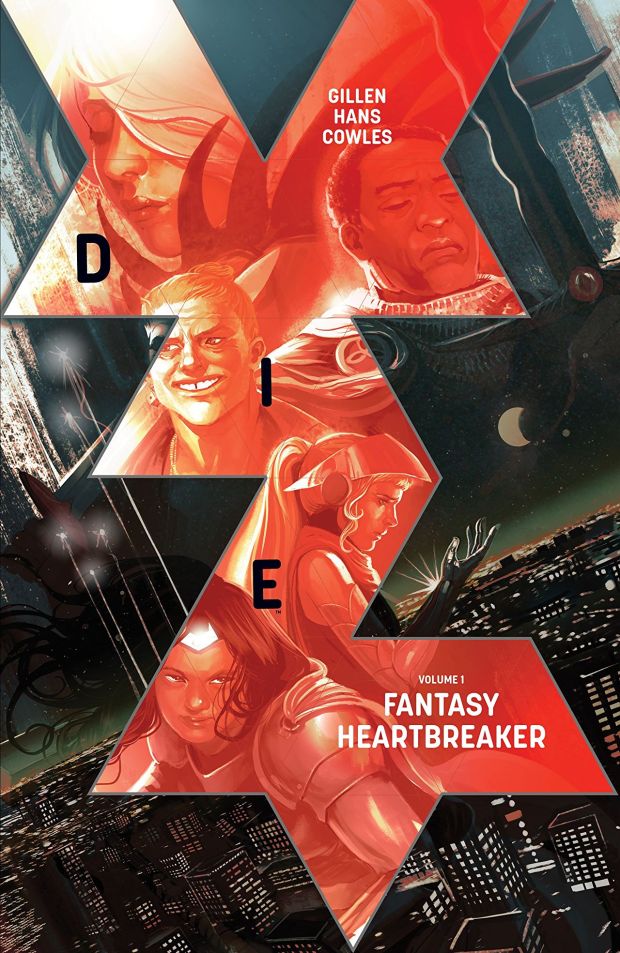by Kieron Gillen, Stephanie Hans, Clayton Cowles
collects Die #1-5
volume reviews one | two
Fans of fantasy and Dungeons & Dragons will eat up Die,a compelling, innovating story with its own companion role playing game.
When a group of six teens begin a fantasy RPG (role playing game), they’re sucked into the fantasy world Jumanji style. The teens return two years later, but one of them is missing. After another massive time jump, the group reunites…twenty five years later. They’ve been called by Sol, the sixth teen who spent the last two and a half decades in the game. He’s now the Game-master, and the five adults reluctantly return to the fantasy land Die to fetch their friend.
Gillen’s writing highlights the best things about roleplaying games: the escape into another world (here, it’s literal); choosing a character that fits or clashes with your own identity; and the thrill of one’s choices playing out in real time. He mixes well known fantasy genre characters (such as elves and trolls) with RPG classes (such as rogues and clerics) to create an original RPG world. For example, Isabelle is a fun take on the cleric – instead, she’s an atheist who barters with gods for favors.
This is Stephanie Hans’ first ongoing series, but her art feels like veteran work: there is nothing hesitant about her bold, broad strokes of largely red and black that confidently sets a strong tone for Die’s violent and unpredictable world. She handles wordless action scenes beautifully, and the characters’ costume designs were realistic and not too overdone.
Gillen chooses an unexpected theme for the epic fantasy genre: a midlife crisis story. The five adults are forced to confront their past selves, each other, and Sol, now distorted by the game. Unfortunately, Gillen spends so much time world building, he sacrifices character and relationship building, and the story suffers for it.

Gillen can easily handle a large cast of characters (WicDiv, Young Avengers) but in Die we’re introduced to all six, who have an adventure we don’t see, and then come back in 25 years, only in the space of a few pages. It’s a lot to unpack without pages of exposition – who they were, who they are now, and how the character they’re playing represents a union or tension between those two. (For example, Chuck is still perfectly happy as the foolish tank; Angela is in a custody battle for her children; Dominic chose a female character, but it’s unclear if there will be any queer themes in the book.) Plus, elements of the world are reminiscent of their lives as teens: an elven queen is modeled after Dominic’s middle school crush, enemies are bullies, and Isabelle’s cult uses her diaries as religious texts.
These were all important moments, but too short beats in between battles and lots of world building jargon. The story misses an anchor of the group’s relationships with each other, aside from siblings Ash and Angela.

Clayton Cowles, one of Gillen’s longtime creative partners, kills it with the lettering. Ash’s costume is reflected in her lettering, and the combination changes when she uses her powers. Cowles also composes different lettering and text boxes for the letter of a dying man, fables, flashbacks, and Isabelle’s gods – it adds a more visceral layer to the fantasy experience and seamlessly bridges Gillen’s writing with Hans’ art.
My last minor concern was the RPG dice themselves. In the first issue, each player describes their character and receives one ‘die’ instead of a full set that players usually use in RPGs. A roll of the dice determines whether your plan succeeds, fails or somewhere in between; often the kind of roll dictates which dice used. So it’s significant that each player only gets one die. The choices seem to reflect their characters (straightforward tank Chuck gets the basic D6, while dungeon master Sol gets the D20) not to mention – the name of the book is Die!
So it’s a mystery how the dice themselves work in-game, when the characters seem to just act regardless of their die. Maybe it’s symbolic of the escape one experiences during an RPG, but it’s still a lot of intentional setup for no payoff…unless it’s simply introducing a mechanic for the Die RPG, currently in open beta. However, it would be disappointing if the die conceit is pure marketing for the RPG, as though the story is a companion piece, rather than the other way around.

The ending was confusing, like a cliffhanger tacked on for its own sake, but I’m intrigued by this visceral and grown up fantasy world, not to mention the unique idea of adults returning to teenage personas. Looking forward to the next chapter.
